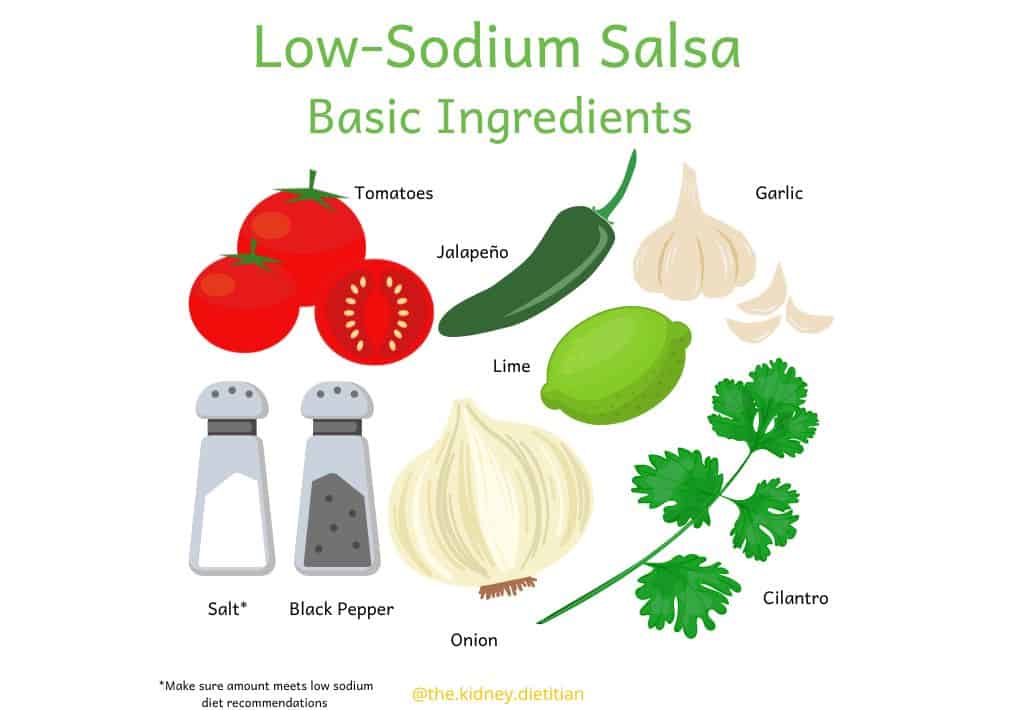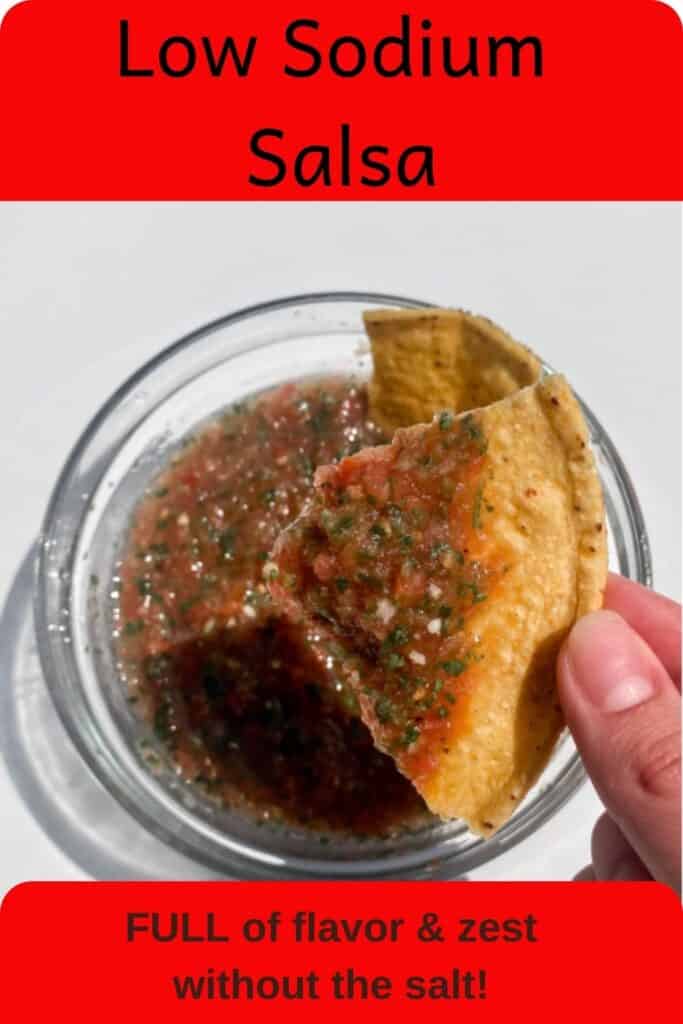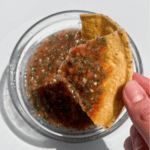This post was written by dietetic student Vanessa Torres and reviewed by Melanie Betz MS, RD, CSR, FAND.
Salsa, a vibrant and zesty condiment, has become a staple in many households worldwide. With its combination of tomatoes, onions, peppers, herbs, and spices, salsa adds a burst of flavor to a variety of dishes. But, if you need a low-sodium diet, it can be important to look for low-sodium salsa.
*Please note that this post contains clearly identified affiliate links. If you click on these links and choose to make a purchase, I may receive a commission (at no cost to you). As an Amazon Associate I earn from qualifying purchases.
Table of Contents
Sodium in Salsa
Summer is the perfect time for salsa and chips. Salsa can be a refreshing appetizer or a delicious topping.
But, you may not have considered the need for low-sodium salsa. Store-bought and restaurant-style salsa can be high in sodium. Many salsa recipes do not list the exact measurement for salt in their recipe, simply “to taste.” So, you have no idea how much sodium is in the salsa.
The sodium in most store-bought salsa can be up to 250mg per 2 tablespoon serving.
This flavorful low-sodium salsa recipe was created for people who want to control the sodium in their diet without sparing flavor. You can enjoy this low-sodium salsa without blowing your sodium goals.
Is Low Sodium Salsa Healthy?
Traditional salsa can contain high amounts of sodium due to the salt used for flavor enhancement. Low-sodium salsa aims to provide a healthier option.
Salsa contains ingredients like tomatoes, onions, peppers, and herbs, which are rich in essential vitamins, minerals, and antioxidants. These ingredients provide important nutrients such as vitamin C, vitamin A, and dietary fiber, supporting a healthy diet and contributing to overall well-being.
Sodium 101
Sodium is a nutrient of concern for those with kidney disease, kidney stones, heart disease, liver disease, and some other health conditions.
A mineral found in many foods, sodium is crucial in maintaining our bodily functions. Excessive sodium consumption, however, can have harmful effects on our health. A diet high in sodium has been linked to health issues, including high blood pressure, heart disease, stroke, and kidney problems.
The Dietary Guidelines for Americans recommend a daily sodium intake of 2,300 mg of sodium per day. For individuals who are at higher risk of hypertension, including those with high blood pressure, diabetes, or kidney disease, the American Heart Association advises limiting sodium intake further to 1,500 mg per day.

Understanding the Connection Between Sodium and Kidney Stones
Kidney stones are a painful and frustrating condition. A low-sodium diet should be part of prevention for most people with calcium kidney stones. While this might seem challenging at first, it doesn’t mean you have to sacrifice flavor and enjoyment in your meals.
Sodium can play a significant role in kidney stone formation, as eating too much sodium can lead to higher calcium levels in the urine. This, in turn, raises the risk of developing calcium kidney stones. If your 24-hour urine test results reveal high urine calcium, it is crucial to monitor your sodium intake and opt for low-sodium alternatives when you can.
Potassium in Salsa
Potassium is an essential mineral that plays a vital role in various bodily functions, including nerve and muscle function, as well as maintaining a healthy heart rhythm.
Tomatoes are often on the “bad” list of foods for kidney disease because of their higher potassium content. But, tomatoes are NOT off-limits.
It’s important to put potassium in any food into context. The amount of potassium you’ll likely get from a serving of low-sodium salsa is minimal. This low sodium salsa only has 50mg potassium per 2 tablespoons.
Importantly, many people with kidney disease do not need to limit potassium. The majority of individuals can safely consume tomatoes without concerns regarding their potassium levels.
While high potassium levels are a concern, reducing potassium from fruits and vegetables (like tomatoes) should be a last resort. In fact, a high-potassium diet is beneficial for many people with kidney disease. Eating enough potassium can help control blood pressure and help prevent kidney stones.
Remember that the other ingredients in your salsa, such as onions, peppers, and herbs, contribute to the overall flavor and nutritional profile. So, even if you choose to reduce the amount of tomatoes slightly, you can still achieve a delicious and kidney-friendly salsa.

The Quest for Flavorful and Low Sodium Salsa
Traditional store-bought salsas often contain high levels of sodium, making them difficult to fit in a low-sodium diet. However, making your own low-sodium salsa at home allows you to control the ingredients and flavors while keeping sodium levels in check.
Fresh Ingredients are Key for Tasty Low Sodium Salsa
Start by choosing the freshest and ripest produce available. Opt for juicy tomatoes, crisp onions, vibrant cilantro, and zesty peppers. These ingredients will infuse your salsa with natural flavors and textures, reducing the need for excessive sodium.
Use Natural Flavor Enhancers
To compensate for the reduced sodium, turn to natural flavor enhancers like lime juice, vinegar, herbs, and spices. These additions not only add depth to the taste but also offer various health benefits.
Consider incorporating garlic, cumin, paprika, or even a touch of chili powder to give your salsa that extra kick.
Experiment with Alternative Ingredients
Get creative with your salsa recipe by exploring alternative ingredients. For example, instead of using regular table salt, try substituting it with The Kidney Dietitian approved salt substitutes. These swaps can contribute to a lower sodium content while still imparting a delightful taste.
Control the Sodium Content
While making your own low-sodium salsa is an excellent way to reduce sodium intake, you must be mindful of other ingredients you add to your creation. Be cautious when choosing canned ingredients like canned tomatoes or beans, as they often contain added sodium. Opt for low-sodium or no-salt-added options instead.
How to Eat Low Sodium Salsa
Pair with Chips
Tortilla chips are a classic pairing with salsa. But, they can add a ton of sodium. Look for low sodium tortilla chips to keep your snack low sodium!
Tips for Choosing Low Sodium Tortilla Chips
Read the Nutrition Label
Look for tortilla chip brands that explicitly state “low sodium” or “reduced sodium” on the packaging. Check the sodium content per serving and look for chips with less than 140mg sodium per serving.
Compare Brands
Different brands offer varying sodium levels, so it’s worth comparing options before making a purchase. Some brands may even offer unsalted or lightly salted versions.
Go for Homemade
Consider making your own tortilla chips using corn tortillas. Baking them in the oven allows you to control the amount of salt or find flavorful alternatives, such as spices or herbs
Use As a Topping
Tacos, Burritos, and Quesadillas
Top these with your low-sodium salsa for a burst of flavor.
The contrasting textures and temperatures create a delightful combination. The acidity of the salsa cuts through the dish’s richness, creating a harmonious balance.
Salad, Grain or Rice Bowls
Using salsa as a salad dressing is a fantastic way to add a flavorful twist to your bowls. Get creative with your salad ingredients and enjoy the explosion of flavors that salsa brings to your plate!
Meats and Seafood
Drizzle your low-sodium salsa over grilled chicken, steak, or fish to infuse them with a vibrant taste. The acidity and spices in the salsa complement the smoky flavors beautifully.
Salsa can be transformed into a delectable sauce or marinade, enhancing the flavor profile of various dishes.
Low Sodium Salsa on the Market
Don’t have time to prepare this low-sodium salsa recipe at home? That is alright! Here are some low-sodium salsa options available:
- All-Natural Black Bean and Corn Salsa by Dennis’ Gourmet*: 70 mg sodium per 2 tablespoons
- Green Mountain Gringo, Medium Salsa*: 80 mg sodium per 2 tablespoons
- Hudson Valley Harvest Red Salsa: 85 mg sodium per 2 tablespoons
- 365 by Whole Foods Market, Organic Thick & Chunky Medium Salsa*: 140 mg sodium per 2 tablespoons
Conclusion
Adopting a low-sodium diet doesn’t mean you have to bid farewell to salsa. With a little creativity and a focus on fresh ingredients and natural flavor enhancers, you can enjoy a delicious, low-sodium salsa that adds excitement to your meals without compromising your health.
Remember, it’s always wise to consult with a healthcare professional or registered dietitian to discuss your dietary needs, including managing kidney stones. By taking control of your diet and exploring low-sodium alternatives, you can savor the zesty goodness of salsa while supporting your kidney stone management journey.
Low Sodium Salsa
Ingredients
- 4 small tomatoes small
- 1/4 medium white onion
- 1 jalapeno stem and seeds removed
- 1 clove garlic
- 1/2 cup fresh cilantro chopped
- 1 lime juices
- 1/2 tsp salt
- 1 tsp black pepper
Instructions
- Prepare the produce by rinsing. Cube the tomatoes. Roughly chop the clove of garlic, onion, and cilantro. Remove the stem and seeds of the jalapeno, then roughly chop.
- Place ingredients into a food processor. Add the tablespoon of lime juice to the food processor.
- Blend the ingredients, and be careful not to puree; some texture is ideal for salsa.
- Serve and enjoy!


I heard that tomatillos for salsa are better than red tomatoes because of the potassium content (salsa veerde); is it true? anyone have knowledge of this?
Tomatillos are lower in potassium, so might be a better choice. However, it is important to think about how much potassium salsa made with tomatoes is really giving you in the grand scheme of things. Also, if you even need a lower potassium diet.
How would you suggest altering the recipe if you don’t like cilantro?
I would just leave it out!
Sodium levels
Mision medium & mild salsa 95mg.
Trader joe’s Unsalted Tortilla chips 0mg.
Taco Bell Taco Shells 0mg.
Great finds!
Just wondering if canned tomatoes (no salt added variety) are considered any worse than fresh tomatoes as far as oxalate content is concerned. Can’t find any answers to this at all and I miss making chili, pasta sauce, soups, etc easily with the canned variety. Thanks!
I would assume they are about the same as cooked fresh tomatoes.